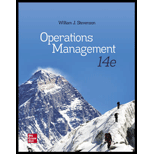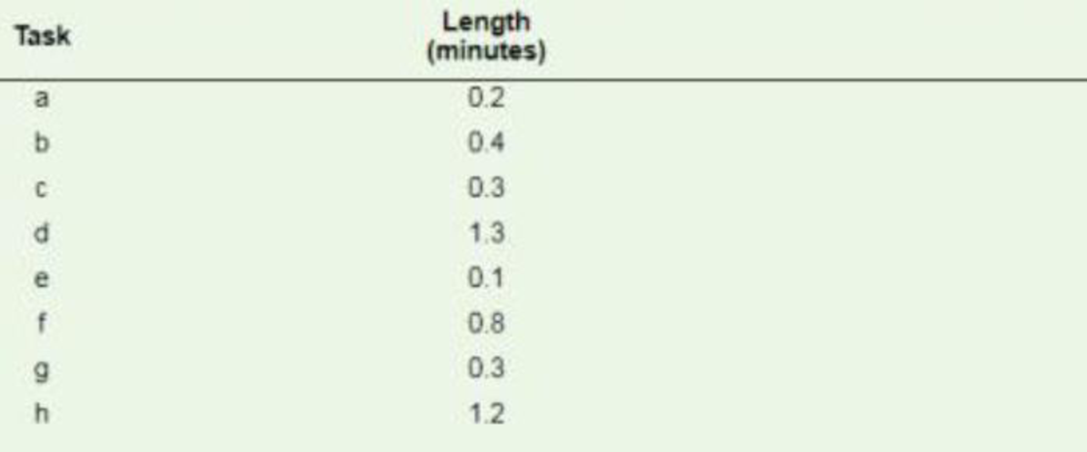
Concept explainers
A producer of inkjet printer is planning to add a new line of printers, and you have been asked to balance the process, given the following task time and precedence relationship. Assume that cycle time is to be the minimum possible.

a. Do each of the following:
(1) Draw the precedence diagram.
(2) Assign tasks to stations in order of most following tasks. Tiebreaker, greatest positional weight.
(3) Determine the percentage of idle time.
(4) Compute the late of output in printers per day that could be expected for that line assuming a 420-minute working day.
b. Answer these questions:
(1) What it the shortest cycle tone that will permit use of only two workstations? Is this cycle time feasible? Identify the tasks you would assign to each station.
(2) Determine the percentage of idle time that would results if two stations were used.
(3) What is the daily output under this arrangement?
(4) Determine the output rate that would be associated with the maximum cycle time.
Want to see the full answer?
Check out a sample textbook solution
Chapter 6 Solutions
EBK OPERATIONS MANAGEMENT
- Karina Nieto works for New Products Inc., and one of hermany tasks is assigning new workers to departments. Thecompany recently hired six new employees and would likeeach one to be assigned to a different department. The em-ployees have completed a two-month training session ineach of the six departments from which they received theevaluations shown below (higher numbers are better).Determine how the new employees should be assigned todepartments so that overall performance is maximized.arrow_forwardThe Simple process has 4 steps. Step 1 & 3 has two resource units, while Step 2 and 3 only has one. The time it takes each resource unit to complete the step is also shown on the diagram. I need help understanding these and the steps that needs to be taken to answer these questions (i) What is the total capacity of the resource units in (units/hr) at each step? (ii) At which of the four steps is there a bottleneck resource pool? (iii) What is the overall process capacity? (iv) If 300 units/hr worth of raw materials flowed into the process, what would be thethroughput of the process?arrow_forwardGiven the following task, times, and sequence, develop a balanced line capable of operating with a I 0-minute cycle time at Dave Visser's company. a) Draw the precedence diagram.b) Assign tasks to the minimum feasible number of workstations according to the greatest time remaining (ranked positional weight) decision rule.c) What is the efficiency of the process?arrow_forward
- Alocal toy manufacturer is using a production line that runs 8 hours per day and produces a toy that requires a total of 7 tasks to be performied. The daily demand is 150 toys. Times of the tasks are 2.73, 2.01, 2.13, 2.0, 2.61, 2.71, and 2.95 minutes for A, B, C, D, E, F, and G, respectively. However, due to the nature of the product there are precedence rules that must be observed. Such that Task A does not need any predecessors; task B requires taskA to be completed. To start task Cand task D, each require task B to be completed. Task C must be completed prior to stating task E. Task F needs both task D and task Eto be completed. Finally, task G can start only once taskFis completed.What is the minimum number of workstations needed?arrow_forwardAlocal toy manufacturer is using a production line that runs 8 hours per day and produces a toy that requires a total of 7 tasks to be performed. The daily demand is 100 toys. Times of the tasks are 2.73, 2.01 201 2.13, 2.0, 2.61, 2.71 , and 2.95 minutes for A,B,C,D,E,F, and respectively. However, due to the nature of the product there are precedence rules that must be observed. Such that Task Adoes not need any predecessorsB requires task A to completed. To start task C and task Deach require task B to be completed. Task C must be completed prior to stating task E. Task F needs both task D and task Eto be completed. Finally, task G can start only once task Fis completed.Given we apply the most remaining tasks rule for balancing the assembly line with ties broken according to longest task time firstthe tasks that will be assigned to the SECOND workstation arearrow_forwardA local toy manufacturer is using a production line that runs hours per day and produces a toy that requires a total of 7 tasks to be performed. The daily demand is 100 toys. Times of the tasks are 2.73, 201 01, 2.13, 2.0, 2.61 2.71. and 2.95 minutes for A, BC, D , and G, respectively. However, due to the nature of the product there are precedence rules that must be observed. Such that Task A does not need any predecessors; task B requires task A to be completed. To start task and task each require task B to be completed. Task must be completed prior to stating task E. Task F needs both task Dand task E to be completed. Finally, task G can start only once task Fis completed . What should be the calculated cycle time in minutes?arrow_forward
- A local toy manufacturer is using a production line that runs 8 hours per day and produces a toy that requires a total of 7 tasks to be performed . The daily demand is 100 toys. Times of the tasks are 2.73,2.01 1,2.13,2.0,2.61,2. 2.71 , and 2.95 minutes for A, B, C, D, E, F , and G , respectively . However , due to the nature of the product there are precedence rules that must be observed . Such that Task A does not need any predecessors ; task B requires task A to be completed . To start task C and task D, each require task B to be completed . Task C must be completed prior to stating task E. Task F needs both task D and task E to be completed . Finally , task G can start only once task F is completed . What should be the calculated cycle time in minutes ? a. 0.9 b. 4.5 c. None is correct d. 4.8 e. 4.4arrow_forwardA local toy manufacturer is using a production line that runs 8 hours per day and produces a toy that requires a total of 7 tasks to be performed. The daily demand is 100 toys. Times of the tasks are 2.73,2.01,2.13,2.0.2.61,2.71 , and 2.95 minutes for A A,B,C,D,E,F, and G, respectively. However, due to the nature of the product there are precedence rules that must be observed. Such that Task A does not need any predecessors; task B requires task A to be completed. To start task C and task D. each require task B to be completed. Task must be completed prior to stating task E. Task F needs both task D and task Eto be completedFinally, task G can start only once task Fis completed.Given we apply the most remaining tasks rule for balancing the assembly line, with ties broken according to longest task time first, the tasks that will be assigned to the THIRD workstation arearrow_forwardFind the value of X in the following Flow Shop data consisting of 5 jobs which are to be processed on two machines M1 & M2 in that order. Jobs M1 M2 A 5 7 B 2 5 C 1 3 D 4 6 E 13 3 For the sequence using Johnson’s Rule, the Make span = Xarrow_forward
- As the Cottrell Bicycle Co. of St. Louis completes plans for its new assembly line, it identifies 25 different tasksin the production process. VP of Operations Jonathan Cottrell now faces the job of balancing the line. He lists precedencesand provides time estimates for each step based on work-sampling techniques. His goal is to produce 1,000 bicycles perstandard 40-hour workweek.Balance this operation using the shortest operation time rule and compute the efficiency of the line.arrow_forwardA visa application process from a Tumaritis country can be described in the chart below. The head of visa administration notices that the visa processing process has gone wrong and decides to examine the whole process. a. Explain the difference between bottlenecks and constraintsb. Identify the bottleneck of this process and explain your answerc. Calculate the throughput time of the above process and explain how many files can be processed in 1 hour?d. Explain how to solve the problem in the above process.arrow_forwardDevelop a solution for the following line balancing problem, allowing a cycle time of 5 minutes. Draw the precedence diagram for the set of tasks. Calculate the minimum number of workstations. Show what tasks are assigned to which stations? Using the heuristic rules How much idle time is there, summed over all workstations? What is the efficiency of this line? Work Task Task Time (seconds) Immediate Predecessor(s) A 70 - B 60 A C 120 B D 60 - E 240 C, D F 100 A G 190 E, Farrow_forward
 Practical Management ScienceOperations ManagementISBN:9781337406659Author:WINSTON, Wayne L.Publisher:Cengage,
Practical Management ScienceOperations ManagementISBN:9781337406659Author:WINSTON, Wayne L.Publisher:Cengage,
